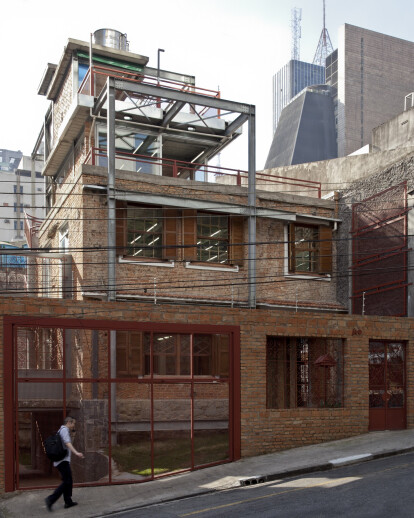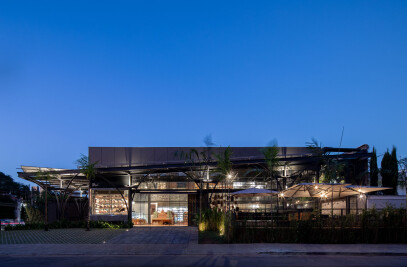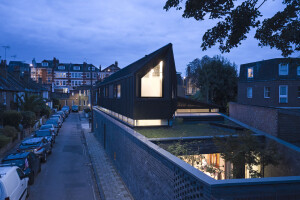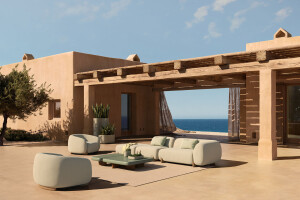Architectonic Concept
The history of this house, located a few meters from Paulista Avenue, starts at the beginning of XX Century as the first legal blueprint dated on 1915 shows. Modest in proportions compared to the big houses in the region however rich in details, it has undergone for several reforms over its almost one century of existence. A small survivor in a region where today is impregnated of high towers with glass façade. Because of that we decided to maintain the house.
To adapt the small-compartmentalized areas of the house to its new commercial purpose, we decided to unify the spaces. Creating large spaces that can be closed according to the client’s need, thus giving great flexibility to the space. This changes demanded big structural interventions. Therefore we defined that all the interventions would be explicit to show the contrast between the new and the old.
Volumetry and Implantation
Seeking for the highest coefficient of utilization, without loose the edification characteristic of the house, a deep study was made which legislation; energetic efficiency and the different periods in which the house had passed were an important factor.
The demolition of the poorly exploited areas aloud the construction of two floors. These were building respecting the new setbacks, which has created a pyramidal volumetry. Thus all the spaces have direct access to generous terraces. During the basement excavation for the foundations execution, beautiful foundations made of large bricks were found. This space was tapped as technical area for the electrical and hydraulic installations also the elevator hound house and a new underground floor.
Structure
Due to the old age of the house made of structural masonry, it was chosen to create an independent steel structure as an exoskeleton to transfers the new loads direct to the new foundations, which were literally build under the existing house.
In cases where the walls were compromised different restoration technics were used, such external beans connecting bolts. They compress the walls and prevent them to collapse like a house of cards. This is a widely used technique in medieval restoration in Italy.
Closing and Coatings
On the original floors, walls were peeled showing their different periods and reforms that the house had been through. Bricks arches, concrete lintels with river pebbles were some of the elements that appeared on this phase of the project. The walls that were removed had their material properly stored, and in the right time it was reused to built new walls. The same happened to the wood floor, roof beams, jambs, doors and windows. They were restored and used according to its original function or refurbished to create furniture. As featured on the project we have the external floor, which was executed with the broken tiles, and the door, which was made with the beams of the roof.
The closure of the upper floors was executed with window frames, some parts sliding and others parts fanlight that permit to control the light intensity and natural ventilation. To suit this secular residence to the new use as an office, it was defined we would seek to make the most of the existing qualities, this gets explicit with the reuse of almost all the structure and materials. The floor of the first floors was reinstalled and the new areas floors have a raised floor.
Sustainability
Beyond reuse almost all the existent material, the prefabricated structure reduced dramatically the production of rubble, consequently energetic costs and CO2 emission with transportation. The energy efficiency was a major factor of this project. For this, many studies using electronic models and software of energetic dimensioning was made to define the materials and the openings. The original large walls guarantee a huge thermal inertia, when it allies with cross ventilation they create a pleasant space.
In the new floors sliding window frames allied with fanlight window frames aloud to control the ventilation and optimize natural light insulation. All the rainwater is captured through hidden drains under the raised floor. The water is filtered and stored in two big 10.000 liters reservoir located in the basement. Small reservoirs are located on the top floor allowing the use of water by gravity decreasing the need of pumping without overwhelming the structure.
Spec Sheet
Structure: structural masonry, reinforced concrete and metal structure of carbon-dip galvanized steel. Internal floors: original restored wooden floor, original restored granilite, original restored terrazzo, and elevated pre molded concrete slabs. External Floors: non-slip flooring executed with rubble of the old tiles elevated pre molded concrete slabs. Stairs: White marble and original restored granilite. Restored handrail covers. Walls: Original clay bricks peeled and varnished. New walls built with old bricks from the building itself or foam concrete blocks. Internal lining: apparent prefabricated slab panels. Ceramics and Metals: Apparent copper pipes, sinks developed with concrete tubes that allow the use of gray water on toilets discharge. Lighting: Apparent industrial profiled. Outdoor furniture: benches and planters executed with wood from the structure of the original roof. Frames and doors: original wood doors and frames, cast iron and restored original stained glass windows, new aluminum frame and tempered glass frameless hardware.


































